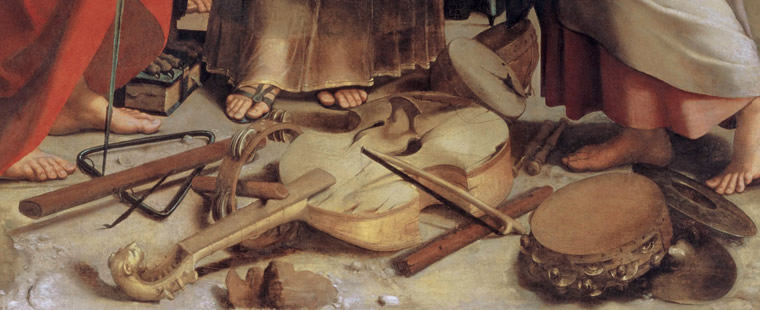
Prof. Dr. Klaus Krüger
Director
Research Project
The concept Bildevidenz takes into account a wide range of historical and thematic points of view, in order that it may be defined, both theoretically and methodologically, with the highest degree of differentiation. One of our main areas of interest concerns the pictorial politics of Evidenz in the late Middle Ages and the question of how images—through the genuine production of Evidenz—shaped and defined the social, political, and religious realms of public life in which they operated as a medium of communication. Special attention will be paid to the way that images (both in municipally or monocratically governed urban societies and at court), by virtue of the specifics of their capacity for visualization, became a consistent component of religious, political, and social activities—in gatherings, legal procedures, rituals, prayer meetings, ceremonies, and celebrations, and how, as an integral element in these forms of communal or institutional symbolization, they also contributed to the latters’ purposes, such as social cohesion, distinction, or negotiation. How do images of the institutional fiction of a particular society—with all its religious, ethical, cultural, political, and other diversities—in fact come to imbue it with an enduring visibility and Evidenz, and, in so doing, with the empowering validity of facticity?
Another research focus is on the relationship between pictorial visuality and rhetorical discourse in the art of the Early Modern Era and the question of the aesthetic means involved in the generation of pictorial Evidenz in the context of medium-related differences and genre-based processes of differentiation. These issues will be addressed partly with regard to the phenomenon (which increasingly came to prominence during and after the Renaissance) of the intermedial configuration of painting and music, whereby the categorical opposition of silence and sound, of visuality and audibility comes to the fore in terms of both medium-related and aesthetic differentness. One central issue here is the question as to how painting, in view of the a priori non-representability of music (due to its invisibility, immateriality, and temporal transience), realizes the expression of audible sound in the form of a visual evocation and hence as an alterity to genuine pictorial, imaginative Evidenz? At the same time, taking the painting of Caravaggio and his followers as a case in point, I will investigate the forms taken by the aesthetic deconstruction of the mimesis-led, rhetorical conceptions of the picture through the erosion and/or de-naturalization of rhetorical, bodily expression. Particular attention will be paid to the semiotic shift (and the shift in reception aesthetics) from representation to presence, from the depicted body to the body of the picture, during which the medium-related effects of presence variously become a specific form of manifestation for pictorially generated Evidenz.
Profile
Prof. Dr. Klaus Krüger studied Art History, German Literature, Philosophy, and Italian Language and Literature at the Ludwig-Maximilians-Universität in Munich. 1985–87: Studentship from the Studienstiftung des Deutschen Volkes. 1987: PhD at LMU, Munich. 1987–92: Grant and post as research scholar at the Bibliotheca Hertziana (Max Planck Institute) in Rome, then research scholar at the Technische Universität, Berlin. 1997: Habilitation at TU Berlin. 1997–99: Research associate at TU Berlin. 1997–98: Acting professor at the Goethe-Universität, Frankfurt am Main. 1999–02: Holder of the Chair of Art History at the Ernst-Moritz-Arndt-Universität Greifswald. 2002–03: Full Professor of Art History (Early Modern Era) at the University of Basel. Since October 2003: Chair of Art History at the Freie Universität, Berlin.
Research Interests
- The theory and history of imagery, sculpture, and the visual media in the Middle Ages and Early Modern Era
- Italian art from the Middle Ages to the Baroque (twelfth to seventeenth centuries)
- The anthropology of images and cultural semantics in the Pre-Modern Era
- Contemporary art
- Art and film
- The history of methodologies
Publications
Bildpräsenz – Heilspräsenz. Ästhetik der Liminalität, Göttingen: Wallstein
2018.
Zur Eigensinnlichkeit der Bilder. Acht Beiträge, Paderborn: Wilhelm Fink
2017.
Visions of Inaudible Sounds: Heavenly Music and Its Pictorial Representations, in: Voir l’au delá. L’expérience visionnaire et sa représentation dans l’art italien de la Renaissance, hg. v. Andreas Beyer, Philippe Morel, Alessandro Nova und Cyril Gerbron, Turnhout 2017, 75-91.
Grazia. Religiöse Erfahrung und ästhetische Evidenz, Göttingen: Wallstein
2016
Musica depicta. The Silent Sound of Painting, in: Senses of Sight. Towards a Multisensorial Approach of the Image (Essays in Honor of Victor I. Stoichita), hg. v. Henri de Riedmatten,Nicolas Galley u.a., Rom 2015, 167-191.
Politik der Evidenz. Öffentliche Bilder als Bilder der Öffentlichkeit im
Trecento, Göttingen: Wallstein 2015 (Rezension von C. Jean Campbell in Zeitschrift für Kunstgeschichte 80/2017, S. 156-159).
Double Vision. Albrecht Dürer & William Kentdrige (Kat. Ausst. Berlin, Gemäldegalerie 2015-16), hg. v. Klaus Krüger, Andreas Schalhorn und Elke Werner, München: Sieveking 2015.
Evidenzeffekte. Bildhafte Offenbarung in der Frühen Neuzeit, in: Evidentia. Reichweiten visueller Wahrnehmung in der Frühen Neuzeit, hg. v. Gabriele Wimböck, Karin Leonhard und Markus Friedrich (Pluralisierung & Autorität, Bd. 9), Münster: Lit-Verlag 2007, S. 391-424.
Das Bild als Schleier des Unsichtbaren. Ästhetische Illusion in der Kunst der frühen Neuzeit in Italien, München: Wilhelm Fink Verlag 2001.
ContactKlaus KrügerCenter for Advanced Studies BildEvidenz Arnimallee 10 Tel.: +49(0)30-838-53865 |


